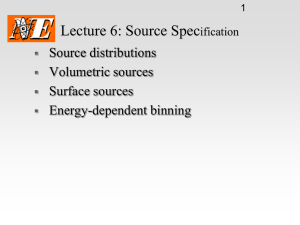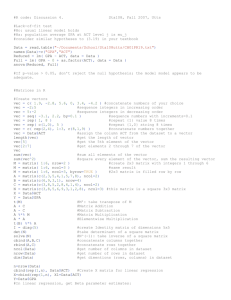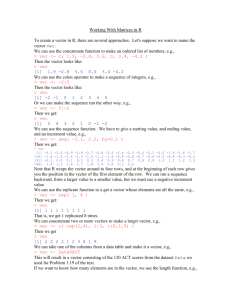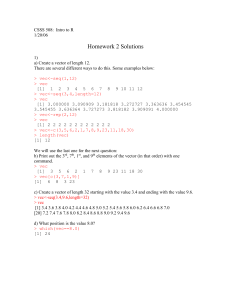Lecture 4
advertisement
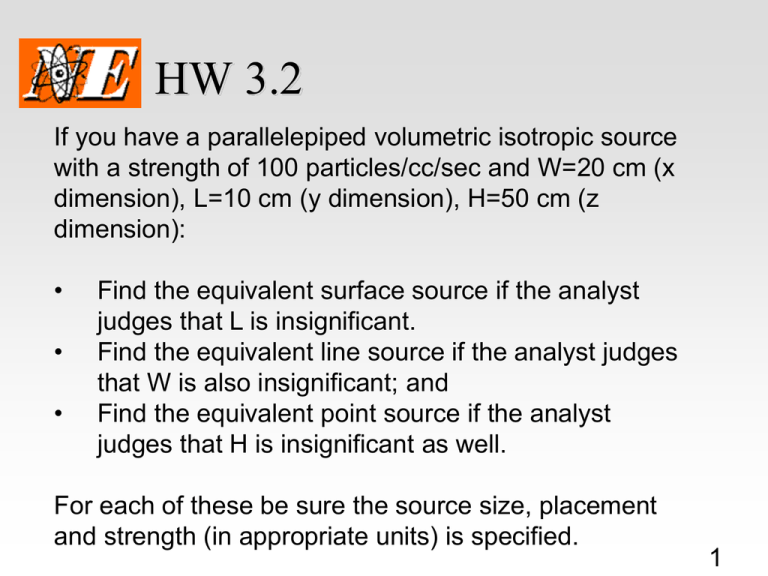
HW 3.2 If you have a parallelepiped volumetric isotropic source with a strength of 100 particles/cc/sec and W=20 cm (x dimension), L=10 cm (y dimension), H=50 cm (z dimension): • • • Find the equivalent surface source if the analyst judges that L is insignificant. Find the equivalent line source if the analyst judges that W is also insignificant; and Find the equivalent point source if the analyst judges that H is insignificant as well. For each of these be sure the source size, placement and strength (in appropriate units) is specified. 1 HW 3.3 For each of the four sources in the previous problem (the original cuboid + the three bulleted approximations) create the source in MCNP—with the origin at the center of the original cuboid—and compute the fluxes at the point (250,0,0) using an F5 tally. 2 3 Source Definition: SDEF Card SDEF card For a point source: PAR=1/2/3 particle type (1/2/3=n/p/e) ERG=xx Energy of particle (MeV) POS=x y z Position indicator Example: 9.5 MeV neutron source at point (1., 4., 5.) SDEF PAR=1 ERG=9.5 POS=1 4 5 4 Advanced Source Specification Source distributions Volumetric sources Surface sources Energy-dependent binning X axis of a distribution: SI Syntax: SIn option I1 I 2 I k Description: The SIn and SPn cards work together to define a pdf to select a variable from. option= blank or Hhistogram =Ldiscrete =A(x,y) pairs interpolated =Sother distribution #’s MCNP5 Manual Page: 3-61 5 Y axis of a distribution: SP • Syntax: SPn option P1 P2 Pk • Description: Specification of y axis of pdf for distribution n. option=blankcompletes SI =-ppredefined function The P values are the y-axis values OR the parameters for the desired function p—and the SI numbers are the lower and upper limits. (Table 3.4) • MCNP5 Manual Page: 3-61 6 Examples SI2 H 0 5 20 SP2 0 1 2 … SI3 L 1 2 SP3 1 2 … SI4 A 0 5 20 SP4 0 1 2 … SI5 1 5 SP5 –21 2 7 8 Input shortcuts Description: Saving keystrokes MCNP5 Manual Page: 3-4 Syntax: 2 4R => 2 2 2 2 2 1.5 2I 3 => 1.5 2.0 2.5 3.0 0.01 2ILOG 10 => 0.01 0.1 1 10 1 1 2M 3M 4M => 1 1 2 6 24 1 3J 5.4 => 1 d d d 5.4 (where d is the default value for that entry) 9 Source description variables Commands: POS=Position of a point of interest RAD=How to choose radial point AXS=Direction vector of an axis EXT=How to choose point along a vector X,Y,Z=How to choose (x,y,z) dimensions VEC=Vector of interest DIR=Direction cosine vs. VEC vector Combinations: X,Y,Z: Cartesian (cuboid) shape POS, RAD: Spherical shape POS, RAD, AXS, EXT: Cylindrical shape VEC,DIR: Direction of particle HW 3.4 Use the Appendix H data to give me the appropriate source description for an isotropic 1 microCurie Co-60 point source that is 10 years old. Use a hand calculation to find the flux at a distance of 100 cm Check your flux calculation with an MCNP calculation using an F5 tally 10 Appendix H 11 12 Source description variables Commands: POS=Position of a point of interest RAD=How to choose radial point AXS=Direction vector of an axis EXT=How to choose point along a vector X,Y,Z=How to choose (x,y,z) dimensions VEC=Vector of interest DIR=Direction cosine vs. VEC vector Combinations: X,Y,Z: Cartesian (cuboid) shape POS, RAD: Spherical shape POS, RAD, AXS, EXT: Cylindrical shape VEC,DIR: Direction of particle HW 3.5 Use an MCNP calculation of a beam impinging on the small water sample to estimate the total cross section of water for 0.1 MeV, 1 MeV, and 10 MeV photons. Compare your answers to the values in Appendix C of the text. 13
